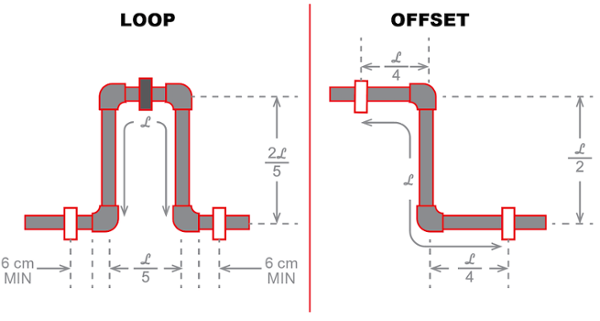CORZAN® CPVC PIPING
INSTALLATION
CORZAN® CPVC PIPING
INSTALLATION
References
The provided guidelines for underground installation are based upon the following:
- ASTM D2774: Standard Recommended Practice for Underground Installation of Thermoplastic Piping
- Piping Manufacturer's Installation Instructions
- Industry Experience
For additional information and data, consult ASTM standards D2774, D2321, or F645.
Installation Procedures
This procedure will cover the typical steps encountered in underground installations: trench design, trench preparation, piping assembly, laying of pipe and backfilling.
Trench Design
The following process should be considered for trench design:
- Width: The trench should be of adequate width to allow for convenient installation, but as narrow as possible, depending on whether the piping will be assembled inside or outside of the trench.
- Depth: The trench depth should be sufficient to place the pipe deep enough to meet frost, above-ground load, and any trench bedding requirements.
- Frost: Piping should be installed at least 12 in. below the frost line.
- Loads: Piping should be deep enough to keep external stress levels below acceptable design stress.
- Bedding: Design stress will be determined by pipe size and operating temperature and may be governed by various codes.
Trench Preparation
The trench bottom should be continuous, relatively smooth and free of rocks. If ledge rock, hardpan, boulders or rocks that are impractical to remove are encountered, the trench bottom should be padded to protect the piping from damage. In such situations, 4 to 6 in. of tamped earth or sand bedding will be sufficient.
Piping Assembly and Placement
Piping may be assembled using conventional solvent cementing techniques either inside or outside of the trench, depending on the specific installation requirements. During the critical curing process, every effort should be made to minimize stress on any joints. To ensure this, the piping should not be moved during the curing period, nor should the pipe be backfilled, or otherwise constrained during curing. See the recommendations on joint curing time to determine the exact curing requirements for a specific installation.
If the piping was assembled outside of the trench, it may be placed into the trench after proper curing, but absolutely can not be rolled or dropped into place. Long lengths of joined piping should be properly supported as the piping is put into place to prevent unnecessary stress.
After proper curing, and before backfilling, the piping should be brought to within 15°F of the expected operating temperature. Backfilling can proceed while the piping is maintained at this temperature in order to minimize stress on the system caused thermal expansion and contraction. If this step is impractical, then stress calculations must be done to determine the loads that will be created due to constrained thermal expansion and contraction. These loads must then be compared to the design stress of the particular piping system.
Backfilling
Backfilling should only proceed after all solvent cement joints have been properly cured and the piping brought close to normal operating temperature, if operation will be more than 15°F different than the current ambient temperature. The piping should be uniformly supported over its entire length on firm, stable material.
Backfill material should be free of rocks and have a particle size no greater than 1/2 in. Piping should initially be surrounded with backfill to provide between 6 in and 8 in of cover. The backfill should be compacted using vibratory or water flooding methods. If water flooding is used, additional material should not be added until the water flooded backfill is firm enough to walk on. Backfill containing a significant amount of fine-grained material, such as silt or clay, should be hand or mechanically tamped.
The remainder of the backfill should then be placed and spread in near uniform layers to completely fill the trench without voids. Particle size for this final fill should not exceed 3 in. Rolling equipment or heavy tampers should only be used to consolidate the final backfill.


